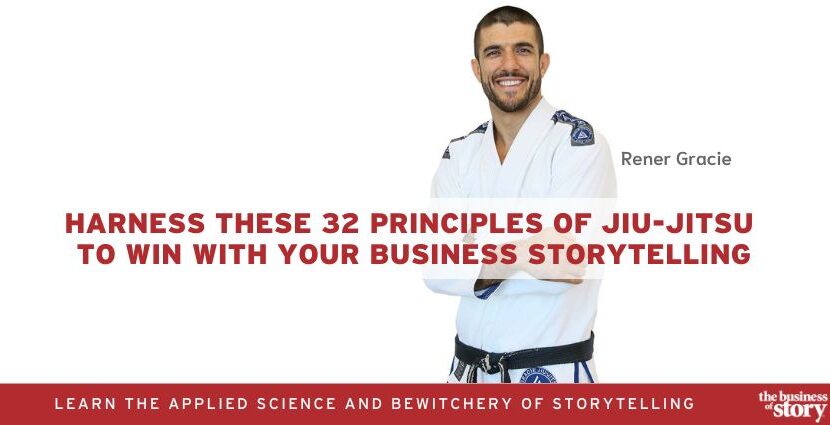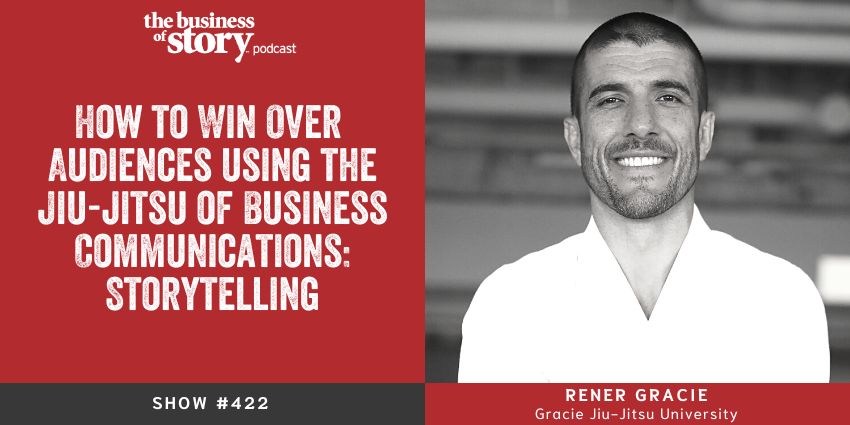Harness these 32 Principles of Jiu-Jitsu to Win With Your Business Storytelling
I not only just read Rener Gracie’s new book, The 32 Principles: Harness the Power of Jiu-jitsu to Succeed in Business, Relationships, and Life, but we explored it on this week’s Business of Story podcast with the author.
While I’ve never studied Jiu-jitsu or grappled on the mat, his 32 principles resonated with me.
In fact, I realized that these same principles can be found in business communications.
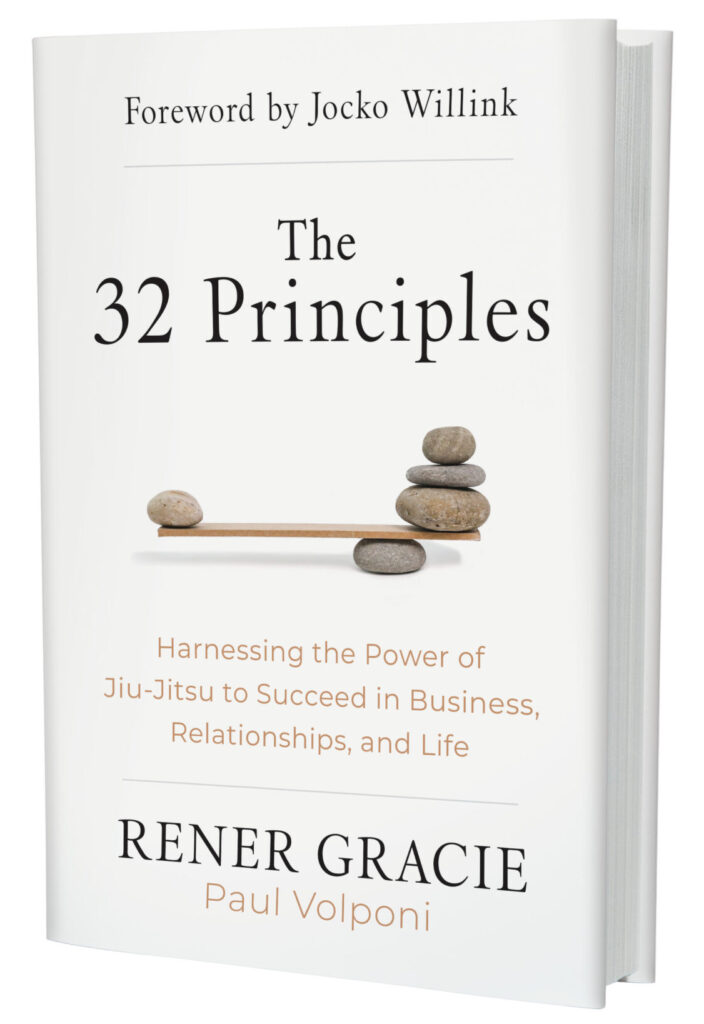 The central theme of his books is that Jiu-jitsu is the art of efficiency. I believe the same is true with disciplined storytelling that makes business communications more efficient.
The central theme of his books is that Jiu-jitsu is the art of efficiency. I believe the same is true with disciplined storytelling that makes business communications more efficient.
For instance, you can use the And, But, Therefore (ABT) agile narrative framework to make your messages land right the first time, every time, fast!
PREMISE: If jiu-jitsu is the art of efficiency, then storytelling is the art of efficient business communications to connect with audiences quickly and persuade them to action.
Let’s examine how business storytelling is grounded in the 32 principles.
#1. The Connection Principle
While the body parts including hands, feet, arms, legs, thighs, hips, wrists, shoulders, fists, elbows, and even armpits are the connection tools in Jiu-jitsu, our stories are the connection tools we use to hook, persuade, and pull in an audience.
Think about the last time you told a story about something you experienced that your audience could relate to. They thought, “Hmmm, I’ve been there. I know what that feels like. She’d kind of like me.”
Anecdotes about what you’ve been through relative to your audience are a powerful way to connect and build trust.
No amount of data, charts and graphs will have the hold on your people like a well-told connection story.
According to Sapiens author, Yuval Noah Harari, “Humans think in stories, and we try to make sense of the world by telling stories.”
#2. The Detachment Principle
“Detachment is profoundly honest, grounded firmly in the truth of what is,” said Sharon Salzberg in Rener’s book.
The Detachment Principle in business communications is when you detach yourself from your opinions and assertions that often create tension. Instead, you illustrate your business points with a true story that shows your position on a situation in action.
Authentic, human-centered stories deliver a truth that creates trust. Leading with features, functions, and figures in your communications is a much weaker way to win over an audience.
#3. The Distance Principle
In Jiu-jitsu, whoever controls the distance controls the damage to be done, according to Rener.
In business storytelling, the storyteller seeks to control the distance between them and their audience, especially adversarial audiences whom they want to win over.
A connection story that demonstrates your shared beliefs and values is a powerful way to reel them in closer to you, which triggers the Connection Principle.
As you are learning, each of the 32 principles is synergistic with the others.
#4. The Pyramid Principle
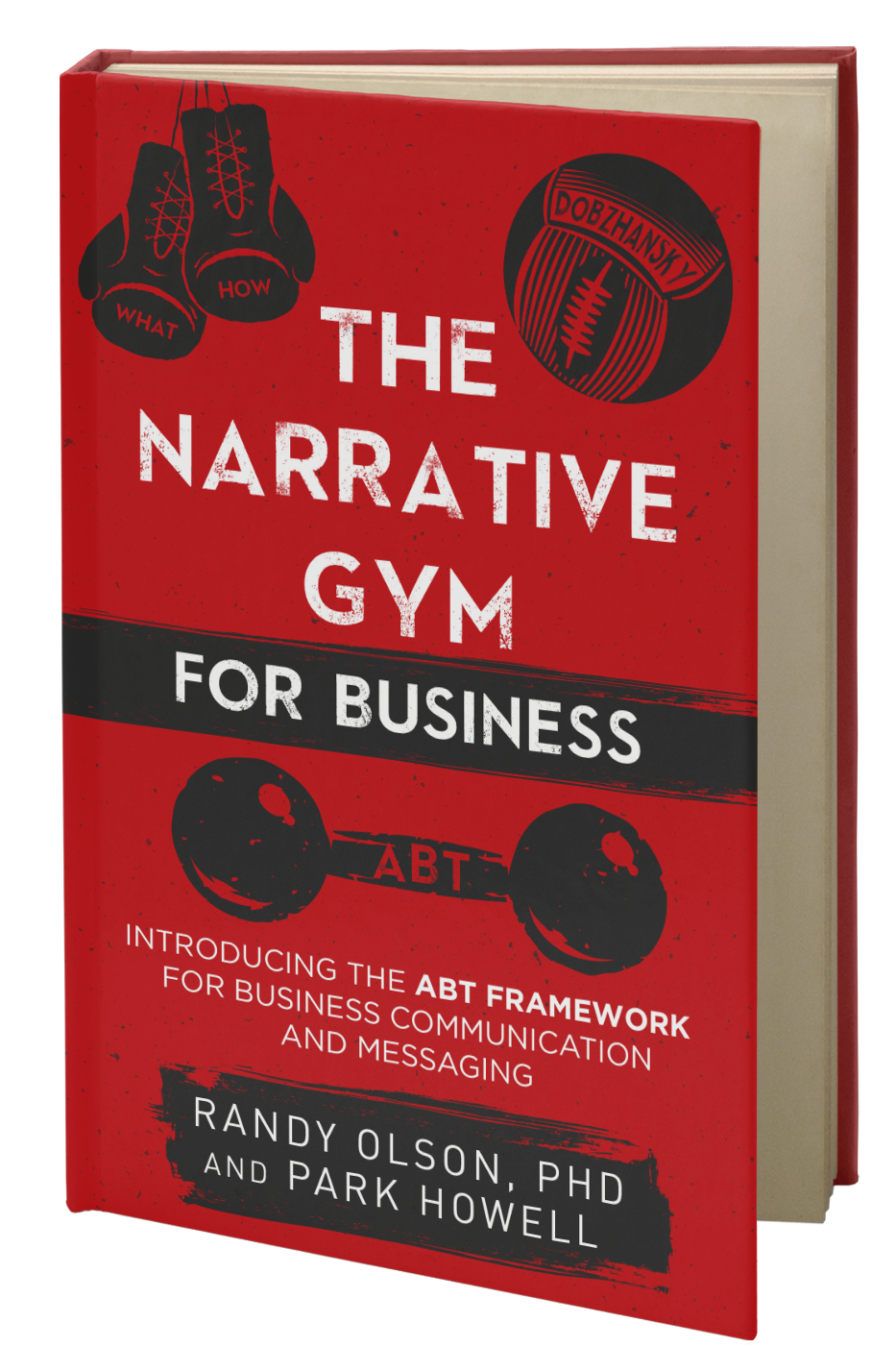 The triangle is a revered shape in Jiu-jitsu because it provides three points of balance for a strong foundation. Hence, the Pyramid Principle. Powerful stories are based on the three-word foundation of the And, But and Therefore (ABT) agile narrative framework
The triangle is a revered shape in Jiu-jitsu because it provides three points of balance for a strong foundation. Hence, the Pyramid Principle. Powerful stories are based on the three-word foundation of the And, But and Therefore (ABT) agile narrative framework
The ABT structure is the DNA of story because it represents the three forces of story, which are Agreement, Contradiction and Consequence.
Think of it as the basic three-act story structure of setup, problem, and resolution.
Our primal problem-solving, decision-making, buying limbic brain loves this problem/solution narrative because it helps it to immediately create meaning out of your message without having to work for it.
That’s why the ABT is the Pyramid Principle in business communications because all persuasive stories are built upon it. Perfect the use of the ABT and you will build a formidable narrative intuition that will make all of your communications land right the first time, every time.
You can learn from my 10-year journey with ABTs of storytelling.
#5. The Creation Principle
The Creation Principle teaches us to use a deliberate action to force a specific reaction from an opponent. To get creative.
Starting with the end in mind, create specific, targeted stories designed to persuade a targeted reaction in your audience.
The Jiu-jitsu of storytelling is not so much a mouse trap as it is the cheese. The goal is for the mouse to grab the cheese without feeling trapped.
Sir Richard Branson, one of the best business storytellers ever, said, “Entrepreneurs who make a difference are, in effect, professional storytellers.”

#6. The Acceptance Principle
Everyone knows that the one constant in life like in Jiu-jitsu is change.
If you resist change, then you burn energy and resources when you could be taking advantage of new opportunities.
The Acceptance Principle in business communications is when you embrace uncertainty, create meaning around why things are changing and demonstrate the way forward through the stories you tell.
“Story, as it turns out, is more important to our evolution than opposable thumbs. Opposable thumbs let us hang on; story told us what to hang on to,” according to Lisa Cron, author of one of my favorite books on storytelling called Wired for Story.
#7. The Velocity Principle
From my book, Brand Bewitchery: How to Wield the Story Cycle System™ to Craft Spellbinding Stories for Your Brand:
“Like thermal dynamics, storytelling has an energy and force all its own. Inspired by the definition of physics, story dynamics is the narrative science that studies imagination and its motion and behavior through the space and time of a story and its related entities of energy and force.
Story dynamics is one of the most fundamental communication disciplines. Its main goal is to help us understand how the universe behaves through the stories we tell and live. We help you use stories to nudge the world in any direction you choose.”
#8. The Clock Principle
The seasoned Jiu-jitsu practitioner uses the Clock Principle to disrupt the anticipated timing of their opponent’s techniques or objectives to control the outcome.
The art of storytelling can provide you with the same advantage by disrupting the objections or anti-stories of others.
In fact, all stories are based on the Clock Principle because they’re temporal. They have a beginning, middle and end.
For instance, your boss just gave you five minutes to state your case. Your prospect opened up 20 minutes for a ZOOM meeting to pitch your wares. The local business club has asked for a one-hour keynote to inspire its young executives.
How deftly you use short, medium and long stories to leverage the synergies of the other principles including Pyramid, Connection, Velocity and Acceptance will determine what belt you have earned in the art of influence and persuasion.
Timing is everything to transport your audience from their world into yours.
#9. The River Principle
The River Principle in Jiu-jitsu is about how well you flow around the obstacles and antagonists that stand in your way of victory. You can exhaust yourself wrestling these adversaries or you can play off of their energy to propel your own agenda forward.
In business storytelling, think of the Pyramid Principle of the ABT agile narrative framework as the hydrodynamics of The River Principle in stories that flow.
Boring stories are slack tides caused by the storytelling, and, and, anding you to death. They go nowhere.
Chaotic stories with no structure are like Class V rapids that are difficult to navigate.
The ideal business story uses the three forces of story of agreement (beautiful, flowing river), contradiction (interrupted by whitewater), and consequence (the splash of excitement and thrill of the ride).
The River Principle is a great way to flow around the anti-stories your audience tells themselves as to why they should not consider your idea. You flow around their objections with a better story that invites them to take action.
#10. The Frame Principle
The Frame Principle is found in how you use the ABT to frame the situation, name the problem, and claim the way forward.
The goal is to overcome your opponent or win over an audience by framing a singular problem/solution narrative to make your position easy to understand, defensible, and intriguing.
How you frame your story using a singular narrative will beat the crap out of obfuscated bullshit every time because you make the complex simple.
Storytelling is the Jiu-jitsu of business communications because it is the art of efficiency.
For instance, the singular narrative upon which the 32 principles in Rener’s book can be summed up in this statement: “Nothing in Rener’s book The 32 Principles makes sense except in the light of efficiency.”
You master the art of efficiency when you frame your stories with a single powerful narrative.
Here’s what legendary Silicon Valley marketer Christopher Lochhead said about the framing power of the ABT agile narrative framework…
#11. The Kuzushi Principle
Kuzushi is a Japanese Martial Arts concept of off-balancing another person.
In business, we are often confronted by fearful opponents who have created fictional anti-stories as to why the organization can’t possibly do what we are recommending. Our job as storytellers is to disrupt the equilibrium of their position on the subject they are against.
For instance, a sales prospect pushes back saying that they tried a similar offering to yours and it didn’t work. An internal team figuratively crosses its mental arms when you introduce a new initiative. Your boss thinks you’re not ready for the promotion you propose.
The only way to overcome an anti-story is to weaken their belief system and throw it off balance with a better story that strengthens your position. Help your audience see and feel the new direction your are promoting.
#12. The Reconnaissance Principle
If you’re going to be successful on the Jiu-jitsu mat, you had better know your opponent’s tendencies.
Legendary Hollywood script guru Robert McKee said that every screenwriter has to know their audience in a God-like way.
The same is true in business. One of the best ways to learn about your audience is The Reconnaissance Principle found in using the ABT as a story-listening device. As Rener says, “Seek first to understand before being understood.”
When someone shares with you their problem, let them go on and on until they’ve exhausted their story. Then repeat back to them what you heard using the ABT framework.
“You want this AND it’s important to you because of this, BUT you’re frustrated because of this thing standing in your way, THEREFORE, imagine what it will feel like when you get it by doing this…”
You will build trust because you demonstrated that you listened leveraging The Reconnaissance Principle with your storytelling skills.
Mark Twain said, “If God intended us to talk more than listen, he would have given us two mouths and one ear.”
#13. The Prevention Principle
In Jiu-jitsu, sometimes winning simply means preventing a move by a superior opponent that will help you avoid a loss. As the strategy goes, postpone the loss for as long as you can and you will eventually win.
When you are battling humungous anti-stories, there are three storytelling moves that are invaluable to your success.
Typically, your opponent is coming at you with all kinds of confusing data and fear-based anecdotes that may or may not be factual to support their position and tear down yours. You allow them to go on for as long as they like as they burn their energy obfuscating the truth. You provide no argument, opinion, or assertion until they have exhausted their points.
Then you leverage storytelling Jiu-jitsu by starting with The Frame Principle. You swiftly state your singular problem/solution narrative using the ABT to create crystal clear meaning for your audience.
You follow with The Creation Principle by telling a quick anecdote using the five primal elements of a short story for big impact to illustrate your business point (show, don’t tell).
You end with The Acceptance Principle by sharing data points that logically support the case you made through the two story frameworks that have piqued their emotional interest in your subject.
You can imagine how The River Principle comes into play to make all of this flow to your benefit.
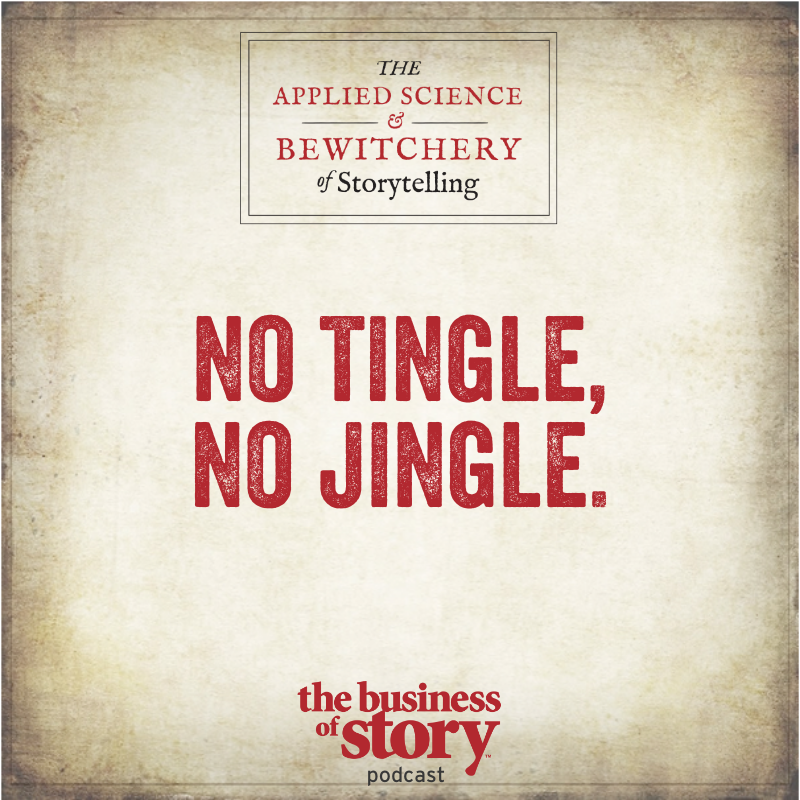
#14. The Tension Principle
Every compelling, persuasive story is built on tension.
No conflict, no story.
Or as I like to say, “No tingle, no jingle.”
When you have truly mastered the Pyramid and Framing Principles of the ABT by strengthening your narrative intuition, then the three forces of story that include agreement, contradiction (tension) and consequence will naturally flow (The River Principle) through your communications.
Stories are about the tense moments when everything changes and the consequences of that change.
#15. The Fork Principle
“To me, the Fork Principle represents the absolute highest level of Jiu-jitsu on the mat. In life, the principle teaches us to pursue optimal outcomes for multiple stakeholders in a given situation,” writes Gracie.
We coach a four-pronged approach to winning over an audience with your stories.
Once you’ve set the stage by framing your singular narrative with the ABT, you then have four different kinds of anecdotes available to you to persuade your audience.
They are all based on moments and include a Moment of Connection that shared your beliefs and values with your audience, a Moment of Truth that illustrates the change that must be dealt with, a Moment of Trust that demonstrates how you are uniquely equipped to help them overcome the fear of change, and the Moment of Victory that shows them what success looks and more importantly feels like.
Each is a true story well-told that invokes the synergies of the 32 principles, as you are beginning to experience.
#16. The Posture Principle
When we find ourselves in an adversarial situation that requires us to argue, even fight, for our position, it’s imperative to observe and understand the opposing position.
Most executives will impotently defend their position using logic and reason based on numbers. “Numb”ers.
The most potent way to overcome their point of view is to use the emotional pull of a true story to create a context for your more exciting way forward. A true story where your audience can picture and feel the outcome will tap out a logical reasoned argument every time.
Famous American social psychologist, Johnathan Haidt, says “The human mind is a story processor, not a logic processor.”
Assume the correct posture to win over your audience by placing the context of your rational idea in the form of an emotional story.
#17. The False Surrender Principle
Very much like The Posture Principle, allow yourself to appear to surrender to the logic behind the opposing viewpoint.
You will come off as agreeable, understanding, and intelligent.
Then when the time is right (The Clock Principle), use The Creation Principle to reveal a new way forward, your way, by using The Fork Principle of deploying any or all of the four story moments as outlined in The Fork Principle.
#18. The Depletion Principle
One strategy in Jiu-jitsu is to wear down your opponent.
But you don’t want to exhaust your audience with your business storytelling.
Instead, when we are faced with the daunting task of creating long-form content including sales presentations and keynote addresses, we have to pay close attention to The Depletion Principle in our audience.
We are not trying to beat them down and goad them into buying our product, service, vision, mission, or initiative.
Rather, we need to execute the Jiu-jitsu move of gingerly escorting them through our content using the 10-step Story Cycle System™ so they eagerly embrace our presentation.
We take what can easily be a long and boring content and create a story arc for our audience that whisks them from their world into ours.
#19. The Isolation Principle
On a Jiu-jitsu mat, one of the main goals is to isolate an opponent’s limb, to leave either that singular arm or leg minus the aid of its accompanying trio of appendages.
In business communications, to overcome an anti-story through persuasion you must isolate the individual arguments.
Weaken their varied premises and the whole of their argument tumbles down around them.
You do this with the storytelling Jiu-jitsu principle of framing that is closely tied to The Isolation Principle because you are wielding a singular narrative that makes your position vastly more understandable and meaningful than a confused assault of multiple reasons why your way can’t be done.
#20. The Sacrifice Principle
One of the greatest obstacles to incorporating storytelling into an organization is its status-quo thinking.
In order to get them to change their ways you have to persuade them to sacrifice the old way of doing things for a smarter, more efficient way that leads to greater ROI.
One of the best ways to do this is to share a moment when you had to sacrifice something for the greater good and what the positive outcome was that you experienced.
To invoke sacrifice in the people you are trying to persuade, lean on The Fork Principle while intuitively employing The River Principle to take them on the journey of sacrifice, healthy change, and positive outcomes.
Demonstrating the sacrifices you have made will help them appreciate that you understand and empathize with their situation.
#21. The Momentum Principle
As a cousin to The Velocity Principle, The Momentum Principle is ubiquitous to storytelling because stories are about a moment when everything changed.
The word moment is derived from the Latin momentum. The Velocity Principle is found in the momentum and energy created by a well-told story.
Business leaders and presenters versed in storytelling understand the importance of toggling between brisk and longer stories to arouse and fulfill the Homo sapiens storytelling creature in every audience.
Ira Glass, host of This American Life, who draws 1.7 million listeners every week to his stories, said “The power of anecdote is so great that it has a momentum all its own…with a well-told story you feel like you’re on a train that has a destination.”
#22. The Pivot Principle
The two most critical assumptions that illustrate The Pivot Principle in storytelling that shift important paradigms are:
- Your stories are not about you but are about your audience, so you must place them at the center of your story.
- Your stories are not about what you make but what you make happen in your audience’s life.
Audiences are pleasantly surprised and vastly more receptive to you and your offering if you pivot your storytelling from your perspective to their point of view.
The Pyramid Principle of the ABT allows you to effortlessly do this by defining your audience, what they want relative to your offering AND why it’s important to them. BUT why don’t they have it? THEREFORE, how are you uniquely equipped to help them get it?
Pivot the two above perspectives and you’ll easily become more persuasive.
#23. The Tagalong Principle
Leading by example isn’t simply the best way to teach. It’s the only way to teach, according to Rener.
When we’re teaching the three proven narrative frameworks of the Business of Story, we encourage a deliberate practice program that I now realize is The Tagalong Principle.
Like with Jiu-jitsu, building any skill requires adopting new healthy habits and deliberate practice.
So to strengthen our students’ narrative intuition we ask them to curl the ABT dumbbell daily through our 21-day Story Quests. We email fun and educational storytelling exercises every Monday, Wednesday and Friday for 10 weeks to help them build their storytelling muscles.
It is a total tagalong exercise.
#24. The Overload Principle
When you take on a formidable Jiu-jitsu opponent, one successful strategy is to overload them either psychologically to keep them guessing what your next move is, or physically by amplify the impact of a particular hold.
But the last thing you want to do with your communications is to overload your audience with confusing information.
You’ll lose them instantly.
Instead, you can overload your audience with emotion using the three story structures we teach. These include the ABT, the Five Primal Elements of a Short Story for Big Impact, and the 10-Step Story Cycle System™, not to mention the four categories of stories: Moments of Connection, Truth, Trust and Success.
Because what you are doing is grappling with the limbic brain connecting with its cause-and-effect, problem-solving, decision-making apparatus.
Your audience is completely unaware as to why they are leaning in, nodding in agreement, and feeling the positive flow of the communication.
That’s why I say, “You have to understand the magic to cast the spell.”
A great example is Martin Luther King’s I Have a Dream Speech. Notice the nested ABTs throughout this revolutionary story.
#25. The Anchor Principle
Once again, the ABT dominates the storytelling mat by exhibiting The Anchor Principle with its singular problem/solution narrative to anchor the promise of the premise of your story.
It’s hard to combat a singular narrative with multiple talking points because our brain, despite popular belief that it can multitask, bets its survival on dealing with one problem at a time.
In his Outside Magazine article, Nicholas Kristof’s Advice for Saving the World, states, “As we all vaguely know, one death is a tragedy, a million deaths is a statistic. As Mother Teresa said, ‘If I look at the mass, I will never act. If I look at the one, I will.’”
Anchor your stories and therefore your audience with a simple singular narrative that will move them to action.
#26. The Ratchet Principle
Our story frameworks, especially the 10-Step Story Cycle System™, are an expression of The Ratchet Principle.
We call our approach to story training the “Applied Science and Bewitchery of Storytelling,” because we know that our frameworks are algorithms. And when you have a persistent mindset of The River Principle, then you’ll continually flow forward with each of the 10 steps in the Story Cycle to ratchet up the story.
We also call this ratcheting a “Story Loop,” which again is based on the ABT.
You invite your audience into the story with your statement of agreement. Then you ratchet up the tension with the BUT statement of contradiction that begs the question in our limbic brian, “How does this end?”. Resulting in the THEREFORE statement of consequence that closes the story loop with your call-to-action of the way forward.
Your goal is to ratchet up the tension and emotion of your stories and then pay it off with your call to action.
#27. The Buoyancy Principle
Leveraging the predictability of human behavior to build your allies and break your enemies is essentially the sole goal of Jiu-jitsu and the storyteller.
When you tell any of the four-pronged story moments found in The Fork Principle, your goal is to buoy your audience, to get them to look higher, and to provide lift by also invoking The Creation Principle.
Watch President John F. Kennedy’s Rice University Apollo speech that ultimately led to $24 billion in funding to win the space race. That’s The Buoyancy Principle of storytelling magnified billions of times.
#28. The Head Control Principle
What is one of the major obstacles when dealing with a leader, boss or manager that is above you?
It’s time.
They seldom provide you with enough time to state your case and sell it.
The Head Control Principle, while obvious in Jiu-jitus (control your opponent’s head), may well be the most important skill to learn with your storytelling to overcome this time triangle headlock. Here’s what you do.
Say your boss has given you just five minutes to share a new initiative you want to spearhead (The Creation Principle). So what you do is take the first 15 seconds (The Clock Principle) and state your powerful singular problem/solution narrative using the ABT to trigger their limbic brain (The Anchor Principle).
Then you take the next 60 seconds (The Velocity Principle) to illustrate your point through a potent anecdote (The Momentum Principle).
Then you roll out no more than three data points to support your stories (the Connection Principle). And you still have three minutes left to measure their interest, discuss options and invite the next step in their process of saying “Yes” (The Acceptance Principle).
That’s how you control the inside and outside *head*.
#29. The Redirection Principle
The Redirection Principle is squarely found in defeating anti-stories with a better story.
But you have to employ The Reconnaissance Principle first to truly understand the point of view of your audience and then follow The Creation Principle to unearth and deliver true stories well told that persuade them into your way of thinking, feeling or doing.
Given the synergies of each of the 31 storytelling Jiu-jitsu principles, you can use nearly every one of them when your strategy is to redirect an audience from their anti-story into embracing your story.
#30. The Mobility Principle
One of the axioms of persuasive storytelling is to meet your audience where they are.
What’s in it for them?
As I mentioned in The Pivot Principle, you have to move from your perspective to their point of view.
Use the Detachment Principle to disconnect from your engrained ideas and leverage The Creation Principle to help them see and feel what a brighter tomorrow can be if only they followed your lead.
As Jack Handy hilariously encourages, “Before you criticize someone, walk a mile in their shoes. That way, you’ll be a mile from them, and you’ll have their shoes.”
#31. The Centerline Principle
You always want to explore and appreciate both sides of the story (The Reconnaissance Principle) to help you distinguish your ultimate centerline.
We call this the “Through Line” of a story framed as your singular problem/solution narrative (The Framing and Anchoring Principles).
Another way of thinking of The Centerline Principle is establishing the moral of your story. How is what you’re about to communicate going to effectively reflect your beliefs and values and what are you willing to do to defend your views.
As NIKE Founder Phil Knight said in his autobiography Shoe Dog, “People, sensing my belief, wanted some of that belief for themselves. Belief, I decided. Belief is irresistible.”
What is the throughline of your singular narrative that centers your story on the business point you want to make, and how does it express the beliefs and values you share with your audience?
#32. The Grandmaster Principle
What makes a Grandmaster Storyteller?
Once you learn the magic of the three narrative frameworks to cast the spell, then make them uniquely your own.
The Business of Story frameworks are simple algorithms for remarkably powerful and persuasive communications.
But they are simply guides.
It is up to the Grandmaster to vamp, improvise and be creative with how to implement these storytelling techniques.
You’ll need to embrace the failure when a story falls flat on its face and celebrate the victories when something surprising, even magical, happens in the telling of a story.
As Steve Jobs, perhaps one of the most gifted storytelling grandmasters, said, “The most powerful person in the world is the storyteller. They set the vision, values and agenda of an entire generation.”
Leveling Up to a Grandmaster of Storytelling
If you’d like to begin your journey in developing your storytelling skills or strengthening what you already have, the best place to start is with our DIY The ABTs of Agile Communications quick online course.
Through three short modules, I show you how to deploy The Pyramid Principle of using the ABT as the foundation for all of your communications to make your messages land right the first time, every time. The other 31 Jiu-jitsu of storytelling principles will begin to naturally fall into place.
I look forward to seeing your ABTs in action.
#StoryOnn!

